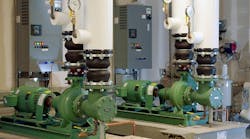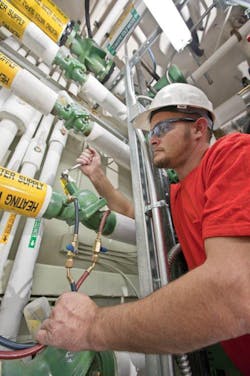Commercial hydronic and domestic-water systems are being scrutinized by experts nationwide. It is happening as the result of systemic introspection that happens when new technology avails a better way of doing things.
Many developments have combined to broadly improve system efficiency—impacting virtually all facets of the connected system—from ease of installation to pumping strategy to operational efficiency to performance.
Why all of the attention? Because the benefits, including greatly enhanced energy efficiency, improved system performance, and prolonged equipment life cycles, are so numerous.
Experts believe what we are seeing is the broad application of technology the time of which has finally come.
Technology That Sets the Pace
Pumps that learn a system’s needs entirely on their own. Boilers that conduct system pumping to beat the band. Volume water heaters designed for extreme efficiency. Self-monitoring, predictive combustion controls. These are among the many parts and pieces that combine to illustrate trends in the hydronics industry today.
For those of us who observe trends in the industry, we see advances like these frequently are at the cutting, exploratory edge of an always-evolving landscape.
Smart pumping is one of those fast-evolving trends. A fine example is new commercial self-sensing pumps that avail systems integration, something “system designers and engineers have worked toward for decades,” Richard Medairos, PE, senior systems engineer and director of commercial training for Taco Comfort Solutions, said. Medairos has spent more than 30 years in the hydronics and commercial-building design industries, most of them as an independent consulting engineer.
Medairos explained one of the latest advances is the expanding reach of sensorless pumps. With sensorless pumping, there are no holes in pipes for tubes or taps connecting remote differential sensors to pumps. Also, self-sensing pump-system design offers the advantages of greater accuracy for variable flow, higher energy efficiency, and improved system stability.
“To make the primary equipment more efficient, we need to control the delta-T and also to match capacity with the load,” Medairos said. “That’s where variable-speed pumping makes its greatest contribution.”
When there is equilibrium between a system’s capacity and load and optimal delta-T, maximum efficiency is attained. Medairos refers to it as a symbiotic relationship between the system and primary equipment.
“To achieve greatest performance, they need each other in a harmonious fit,” Medairos said. “With new and responsive pump technology, we can now strive for optimal system balance.”
A key driver is the rapidly growing use of variable-speed pumps in the hydronics industry. There are substantial benefits:
- If load varies, there is a corresponding reduction in pump speed. With a drop in pump speed, there is a significant reduction in pump power (at half speed, only 1/8 of the full horsepower is required; at 1/3 speed, only 1/27th of the full horsepower is required).
- With variable speed, power is increased gradually. Soft starts are beneficial to the motor, pump, and system components.
- By reducing pump speed to match load, energy is saved, and equipment longevity is improved greatly.
In the opinion of many industry experts, considering all facets of a system are working in harmony, we have arrived at a place and time permitting the type of systems integration to which Medairos refers.
Variable-Speed Pumping = Variable Flow
David Peacock, eastern Tennessee sales manager for Atlanta-based Peacock Sales, and Bryan Payne, president, Taco Industrial/Hydroflo, both affirm the trend toward the use of variable-speed drives for all pumps, both constant and variable flow, is a seismic one. They say the trend is the most powerful they have seen in their 25-plus years in the trade.
According to Payne, the application of variable-frequency drives (VFDs) to constant-speed pumps, a practice that improves the performance and efficiency of both large domestic-water and large hydronic heating and cooling systems, is the fastest-growing segment of the commercial pumping industry.
“The benefits are dramatic,” Payne said. “Fortunately, the cost of drives is decreasing, and the technology offered by drive manufacturers seems to improve daily.”
The advantages of retrofitting constant-speed pumps with VFDs include:
- Greater energy efficiency.
- More-precise flow control.
- Soft starting and stopping of motors.
- The integration of building-management-system (BMS) communication.
- Better balancing with speed control, as opposed to imparting “false” head.
- The ability to adjust flow easily to rerate energy plants when system flow gets out of balance or experiences reduced delta-T.
Peacock pointed to other advantages: Variable-speed technology allows building maintenance professionals to sense dangerous conditions with motors or problems with pumps and can signal a BMS if there are issues, triggering standby equipment to start for redundancy and backup.
“Variable-speed drives do all these things while saving energy and increasing equipment lifespan,” Peacock said.
Boilers With Onboard Controls
At the 2016 International Air-Conditioning, Heating, Refrigerating Exposition (AHR Expo), a boiler with onboard pump controls was an attention getter.
“Combining a 95-percent-thermal-efficiency modulating-condensing boiler with an advanced pump control that seamlessly matches boiler firing rate to pump flow makes great sense,” Chuck O’Donnell, marketing director for Laars Heating Systems Co., said.
“Combining the boiler and pump controls within the box allows us to offer a true system capable of independent, smart operation while reducing boiler pumping costs by up to 70 percent,” O’Donnell continued.
According to O’Donnell, fully modulating and condensing boilers do an excellent job of maximizing both boiler electrical (blower) and boiler combustion efficiency. The third component of installed boiler efficiency, which often is overlooked, is the boiler pump.
“A large savings opportunity exists by using a variable-speed boiler pump that is load-matched to a modulating boiler’s combustion system,” O’Donnell said.
With Laars’ Vari-Prime pump control, total boiler installed efficiency is enhanced by load-matching boiler and pump operation. Additionally, the control system protects a boiler’s most essential component—the heat exchanger—by ensuring a variable-speed boiler pump remains in phase with the boiler’s combustion modulation.
In traditional boiler installations, pumps are sized to match the flow required for full-rate firing. In that scenario, pumps run at full speed every time boilers fire, regardless of the required flow. Vari-Prime, in conjunction with a variable-speed pump, tracks the heating profile curve to dramatically reduce the electrical usage of boiler pumps. That is because a variable-speed pump’s power consumption can drop by as much as 50 percent with only a 20-percent reduction in speed.
“I see real advantage in providing on-board control functionality that balances gas flow, airflow, and now even water flow to optimize boiler efficiency through immediate response to load changes,” Mike Haigh, government/contractor sales manager for Federal Corp., an Oklahoma City-based manufacturer’s representative, and 2016 AHR Expo attendee, said.
Diversification, Greater Efficiency
The U.S. Department of Energy (DOE) estimates residential- and commercial-building heating represents 20 percent to 25 percent of total annual energy consumption in the United States. It is with that in mind that some manufacturers have strategically diversified their operations.
At the 2016 AHR Expo, Bradford White Corp. exhibited a variety of gas-fired hydronic and volume-water-heater equipment.
“DOE has made it very apparent that heating efficiency of buildings will be a major thrust in years to come, and so we continue to expand and enhance our heating products to increase their appeal to the buyers and specifiers within our ever-evolving market,” Carl Pinto, director of marketing for Bradford White, said.
Bradford White’s line of modulating-condensing, low-nitrogen-oxide boilers and volume water heaters includes both residential and commercial models with inputs from 80,000 to 4 million Btuh and efficiencies of up to 98 percent.
“Of course, there are key advantages with a broader product line, availing our entry into new markets and installation opportunities,” Pinto said. “But we also wanted to be sure that, when the new products were rolled out, we did so after rigorous research and product development, with equipment safety and high efficiency as goals that had to be achieved with no compromise.
“The forces of an ever-greening world—with DOE and USGBC (U.S. Green Building Council), among many others, leading the call for greater operational efficiency—provide an excellent growth opportunity,” Pinto added.
Collaboration for Combustion
AERCO’s AERtrim system is an intelligent combustion-control system.
“By directly monitoring the O2 (oxygen) content of flue gases, the system ensures optimal air/fuel ratios for maximum combustion efficiency, stability, and, thus, reliability,” Peter Rimassa, the company’s director of boiler value stream and applications engineering, said.
In the event oxygen levels fall out of a specified range because of gas-pressure fluctuations, air-temperature-density changes, gas heating value, etc., the system adjusts blower speed voltage to bring oxygen levels back to the specified range (and, consequently, achieve optimal air/fuel ratio).
“This capability offers flexibility and peace of mind in the event of combustion-parameter changes while ensuring the highest combustion efficiencies in a heating season,” Nery D. Hernandez, AERCO’s product solutions manager for commercial boilers, said.
In addition to efficiency and flexibility, the system aids in providing uptime reliability, as it notifies the end user of any combustion-system errors or excessive trimming, which may be indicative of other system issues. This allows the end user to take preventive measures.
Self-Balancing Pump Control System
Taco’s LoadMatch is a blend of two technologies—single-pipe distribution and primary-secondary pumping—enhanced by the use of maintenance-free, wet-rotor circulators.
The primary distribution system is a single pipe loop. The secondary distribution system is a relatively tiny, decoupled loop for each terminal unit. Small, low-kilowatt circulators provide the specified flow to each unit, eliminating the need for control valves and most balancing valves.
The system is self-balancing, which reduces many start-up, commissioning, and operational problems because all zones are independent of each other and get their required amount of flow at all times.
In addition to the energy savings typical with hydronic systems, LoadMatch reduces head loss (essentially, resistance within a piped system) by eliminating many control and balancing valves, as well as some pipe. The result is a reduction in primary-pump size by up to 50 percent, according to Jeff Pitcairn, Taco’s commercial regional manager.
Hybrid-Systems Education
“One of the biggest advancements we seek to be involved with at Cleaver-Brooks through education is for facility managers and building owners to gain a greater understanding about how condensing technology works, its limitations, and proper control method,” Brian Huibregtse, product engineer, said. The end results, Huibregtse added, are efficiency gains, higher equipment reliability, and happier end users.
“There is indeed a trend toward hybrid solutions for hydronic heating systems vs. the use of 100-percent condensing boilers—both for new-install and retrofit situations,” Cleaver-Brooks’ product manager, Sean Lobdell, said.
“Hybrid hydronic-system solutions are those that integrate condensing and non-condensing boilers as well as utilizing steam boilers with steam-to-hot-water heat exchangers to provide backup and redundancy for systems,” Lobdell said. “The reason for this hybrid approach is reduced equipment and installation cost, backup fuel-oil requirements, and the advantage of retrofitting existing systems at reduced cost for faster payback.”
Leave it to industrious, restless U.S. manufacturers. Their best efforts, by design, improve yours, too.
The president of trade-communications firm Common Ground, John Vastyan is a journalist who has been writing about the plumbing-and-mechanical and HVAC industries for 25 years. He can be reached at 717-664-0535.
















